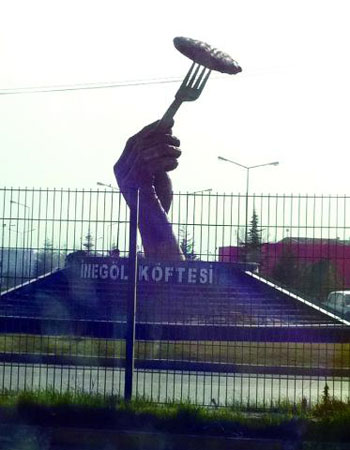A giant brain pouring water on all sides, a large cat wearing a Turkish traditional costume, giant fruits like watermelon, pomegranate, strawberries, tomatoes, a giant bunch of grapes; animals such as a giant red elephant, storks, hens and roosters, shy flamingos that have fallen in love; Turkey’s Van Lake’s Beast, airplanes, a NASA astronaut standing by the seaside, Nasreddin Hodja — the Anatolian humorist who lived in the 13th century in Konya — riding his donkey backwards, whirling dervishes … There is little but one thing that can bring all these things together in Turkey: Being the subjects of a sculpture, reports the Hürriyet Daily News & Economic Review.
Sculptures say the first words about a city to unknown visitors, according to city planner Meltem Parlak, who founded the blog “Spektaküler Şehir Heykelleri” (Spectacular City Sculpture), where images of city sculptures or monuments from all over Turkey are displayed.
“Sculptures are good indicators about the city they inhabit. Large sculptures built carelessly are usually located in cities where the education, healthcare, real estate and infrastructure systems are also carelessly built,” Parlak told the Hürriyet Daily News in an email interview. Pavements where disabled people would be unable to pass, streets that end suddenly, those designed without thinking of the pedestrians and in-mesh houses lacking a certain shape, are also the product of the same approach, she added.
Sculptures can explain much about the city in which they are located only if they are made properly, however, the sculptures in Turkish city’s were strongly related to Kemalism and works portraying the founder of Turkish republic, Mustafa Kemal Atatürk, rather than being related to the cities they pertained to according to Ferit Özşen, a renowned Turkish sculptor and professor at Istanbul’s Mimar Sinan University.
There are “unfortunately” no policies regarding urban artwork for cities in Turkey, according to Özşen. “There are very few such works that have been implemented in the framework of a project, such as the Atatürk monument in [Istanbul’s] Taksim Square or Ankara’s Anıtka Bir Monument.”
Tuesday marked the day when the demolishment of the “Monument for Humanity,” in the eastern border province of Kars, was finalized. The demolition started on April 26, following the Turkish Prime Minister Recep Tayyip Erdoğan’s remarks that the monument was “freakish,” during his visit to Kars in January this year.
“Things should not have reached this point. The artist had done a serious piece and had almost finished it. [The demolishment] is shameful. Now they will do a ‘honey and stager [cheese]’ sculpture, I heard. It is so saddening; I cannot find words to describe my sorrow,” Özşen said.
“Demolishing the Monument to Humanity indicates we live in a country where things we do not like can be destroyed, one that has serious problems with the freedom of expression,” Parlak said.
 Epress.am News from Armenia
Epress.am News from Armenia


